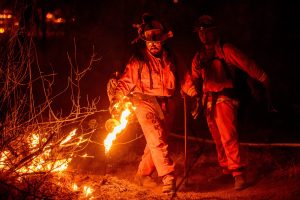In an unexpected twist, authorities have taken Alexandra Souverneva, 30, of Palo Alto, California in for questioning as an arson suspect in the wildfire that has raged through the Shasta County area of northern California since September 22. According to the New York Post, “Alexandra Souverneva, 30, faces up to nine years in prison for allegedly sparking the Fawn Fire, which has destroyed 41 homes and 90 smaller structures and is threatening 2,340 others, officials have said.”
The chain of events started when employees working near the JF Shea and Mountain Gate Quarries reported “seeing a woman trespassing at the property and acting irrationally,” as reported by CBS Sacramento News. The California Department of Forestry and Fire Protection (Cal Fire) reports that Souverneva then was seen emerging from the brush near the fire line and she subsequently approached fire crews for help. After she was treated for dehydration, Souverneva was interviewed, which led Cal Fire officials to believe she was involved with starting the blaze.

Whether this act of arson was intentional or not is still being investigated. However, according to the Daily Beast, Souverneva, “told officials that while she had been hiking to Canada, she became thirsty and attempted to start a fire to boil some bear urine” but was “unsuccessful in starting the fire but drank the urine anyway, and then ‘continued walking uphill from the creek bed,’ when she noticed the smoke and called for help.”
When Cal Fire officer Matt Alexander asked Souverneva to empty her pockets and fanny pack, he found they “contained CO2 cartridges, a cigarette lighter and an item “containing a green, leafy substance she admitted to smoking that day.” As a result, USA Today reports that “Souverneva was arrested and taken to Shasta County Jail, where she was booked on the arson to forestland charges, according to the court filing.”
Souverneva is apparently no stranger to the Shasta County Jail, having spent the previous evening there on an unrelated charge. Moreover, when released, she told Alexander said she walked to an area of vegetation surrounding Shasta Lake. Alexander points out, “It is my opinion there is a high possibility she is responsible for the vegetation fire in Shasta Lake City the previous evening. It is my experience that arsonists … will light multiple fires in a short timeframe.”
There may also be factors that mitigate the full culpability of Souverneva. According to redding.com, “During the court appearance, an attorney said Souverneva had made statements to law enforcement that indicated a possible mental health crisis ‘or something to do with drug abuse.’” When questioned by reporters if Souverneva has admitted to setting the fire, Shasta County District Attorney Stephanie Bridgett remarked, “I can’t get into any further facts than we have already revealed at this time,” but did confirm that Souverneva has also had law enforcement contact related to arson “in our county and other counties as well.”
Between acts of arson and extensive drought conditions, California is quickly becoming a vast tinderbox. As CBS News reports, “Drought and scorching temperatures have turbocharged fires that are more extreme than ever. Two of the biggest fires in state history have laid siege to more than a million acres in Northern California, burning dangerously close to Lake Tahoe. Firefighters haven’t had a day off in months. Fire chiefs warn there aren’t enough aircraft to go around.”
And although it was not arson, The Zogg fire also included human elements. The Zogg fire, according to The Guardian, “erupted on 27 September 2020 in Shasta county during high winds” and “quickly grew and killed four people in the small town of Igo” before spreading “to neighboring Tehama county, scorching more than 88 sq miles (228 sq kilometers) and destroying 204 buildings, about half of them homes.” At the center of this fire was the utility company, PG&E, the US’s largest utility company.
An investigation into the genesis of the fire found that PG&E was negligent with regard to proper maintenance of their electrical lines. Bridgett stated “PG&E as a utility has both statutory and regulatory duties to mitigate fire risks by removing hazardous trees from around their electrical lines. In this case, they failed to perform their legal duties. Their failure was reckless and was criminally negligent, and it resulted in the deaths of four people.”
Arsonists cause incredible amounts of material damage with regard to forest fires, but some use their fire-starting skills for an even more dubious target: firefighters, the very people sacrificing their health and potentially their lives to save people and their homes and businesses.
Just two months ago, as California firefighters were battling the Dixie Fire, which took nearly two months to contain, former college professor Gary Maynard was alleged to start multiple other fires in an attempt to trap firefighters. The U.S. Attorney’s Office in Sacramento said in court papers that Maynard, “entered the evacuation zone and began setting fires behind the first responders fighting the Dixie fire,” adding, “Maynard’s fires were placed in the perfect position to increase the risk of firefighters being trapped between fires.”
Although psychologists don’t fully understand what compels people to intentionally set fires, it is likely a confluence of dynamics and circumstances. As R. Douglas Fields, Ph.D., a neuroscientist, author and Adjunct Professor at the Neuroscience and Cognitive Sciences at the University of Maryland, College Park argues, “Arson can be used as a weapon of revenge or motivated by some other conniving, covert, destructive aim, but fire-setting is also an irresistible compulsion for some, recognized as a form of mental illness. More research is needed, but typically, fire-setting is viewed not as a distinct disorder, but as a behavior that stems from another deep-seated pathology.”
Of course, there are professional arsonists that set fires strictly for financial gain. However, that doesn’t fit the profile of Souverneva or Maynard. That being said, we still sketchy about what characteristics define an arsonist that would set forest fires. Part of the problem is that arsonists, for lack of a better word, are crafty, and so often elude law enforcement. “The truth is, very little is known about arsonists because so few arsons are solved,” says psychologist Joel Dvoskin, PhD, ABPP, of the University of Arizona Medical School and a member of the American Board of Forensic Psychology who has done work on the psychological motivations behind arson.

However, a 1987 FBI Law Enforcement Bulletin may shed some light on who might fit the bill of a nonprofessional arsonist. The report shows that many of the people who commit arson have lower than average IQs. As Dvoskin explains, “In these types of cases, arson is often committed by someone who is retarded but also angry. It’s that combination that is a catalyst — their anger but having fewer means to express it. Honestly, I can’t think of a single arsonist I’ve dealt with for whom anger wasn’t the primary motivator.” However, Dvoskin warns, “It could be that the smarter people get away with it, and less smart people are more likely to get caught.”
FBI Agent Brad Garrett echoes this perspective, stating, “They tend to be undereducated, many of them have not graduated from high school and have average to below-average IQs, but the common theme in all of them is that all of them are troubled… they feel isolated. They feel outside of the world, they’re angry at the world. They want to take revenge sometimes and that is one of the motives of arsonists is revenge. They’re just angry in general and so they take off and light fires.”
This anger component fits Maynard, who although denied he started fires, also went on angry tirades about then-President Trump. Whether or not there is an anger component along with mental health issues for Souverneva remains to be seen. Meanwhile, because of the damage caused by the wildfire, Souverneva’s bail has been increased to $150,000 from $100,000 for the felony charge of arson on forest land, plus $25,000 for a misdemeanor, arson during a state of emergency, the Mercury News reports.
At Newsweed.com, we adhere to three simple principles: truth, balance, and relatability. Our articles, podcasts, and videos strive to present content in an accurate, fair, yet compelling and timely manner. We avoid pushing personal or ideological agendas because our only agenda is creating quality content for our audience, whom we are here to serve. That is why our motto is ”Rolling with the times, straining for the truth.”
Your opinion matters. Please share your thoughts in our survey so that Newsweed can better serve you.
Charles Bukowski, the Los Angeles beat poet that captured the depravity of American urban life once said, “There is something about writing poetry that brings a man close to the cliff’s edge.” Newsweed is proud to stand in solidarity and offer you a chance to get close to the cliff’s edge with our first Power of Poetry Contest. Are you a budding bard, a versatile versifier, a rhyming regaler? Do you march to the beat of iambic pentameter, or flow like a river with free verse? If so, here’s your opportunity to put your mad poetic chops to the test. Enter our poetry contest for bragging rights and an opportunity to win some cash!






